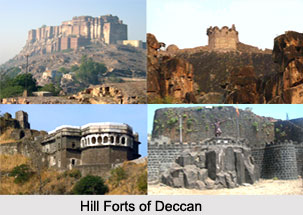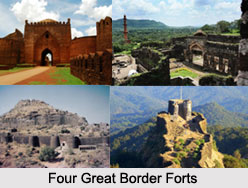 Deccan Forts widely refer to the forts present in the southern parts of the country. Most of the Deccan Forts were founded during the medieval period or the middle ages (8th to 18th century CE) in India. It is believed that the term `Deccan` is adopted from the Sanskrit term `Daksina` which means south. Thus, the term Deccan or Daksina referred to the southern part of the country. This could be broadly described as the region situated toward the south of Narmada River, some parts of Maharashtra, excluding the Marathi-speaking territories, the districts of Solapur, Ahmednagar, South Satara, Kolhapur, North Satara, Poona (Pune), northern parts of Belgaum and Bijapur districts and the southern part of the Nasik (Nashik) district.
Deccan Forts widely refer to the forts present in the southern parts of the country. Most of the Deccan Forts were founded during the medieval period or the middle ages (8th to 18th century CE) in India. It is believed that the term `Deccan` is adopted from the Sanskrit term `Daksina` which means south. Thus, the term Deccan or Daksina referred to the southern part of the country. This could be broadly described as the region situated toward the south of Narmada River, some parts of Maharashtra, excluding the Marathi-speaking territories, the districts of Solapur, Ahmednagar, South Satara, Kolhapur, North Satara, Poona (Pune), northern parts of Belgaum and Bijapur districts and the southern part of the Nasik (Nashik) district.
The Deccan Forts can be broadly divided into three main categories, namely Hill Forts, Land Forts and Four Great Border Forts. These are discussed as follows-
Deccan Hill Forts
The Hill Forts of the Deccan were mainly developed for their strategic positions which provided defence against enemies. The Deccan hill forts can be further classified into three segments, Major Hill Forts, Medium Hill Forts and Minor Hill Forts. The classification is based on the size, defensive structure and historical significance of the forts.
The Major Hill Forts of the Deccan included the Torna Fort, Rajgarh, Sinhgarh, Purandar Fort, Rajmachi Fort, Lohgarh, Jivdhan Fort, Panhala Fort, Visalgarh, Pratapgarh, Sajjangarh, Satara Fort, Chandan Vandan Fort, Kenjalgarh, Santosgarh (Tathvade), Varugarh, Vasota Fort, Dhodap Fort, Trimbak Fort and Ankai Tankai Fort.
The Medium Deccan Hill Forts were Hadsar, Koarigarh, Visapur, Malhargarh, Dategarh (Sundargarh), Mahimangarh, Nandagiri, Pandavgarh, Vardhangarh, Jangli Jaygarh, Makarandgarh, Vairatgarh, Prachitgarh, Machhindragarh, Bhopalgarh, Bhudargarh, Rangna, Aundha Patta, Chandor, Hari, Ramshej, Ravlya-Javlya, Patta and Ratangarh.
The Minor Hill Forts consisted of Chavand, Narayangaon Fort, Tikona, Vichitragarh, Tung, Kamalgarh, Gunvantgarh, Sadasivgarh, Bhairavgarh, Mahimandangap, Pavangarh, Samangarh, Harischandragarh, Kavnai, Koledhair, Kulang Alang, Markinda, Bhorgarh, Tringalvadi, Vaghera, Achla, Ghargarh, Bhaskargarh, Kachna, Bahula, Ahivant, Indrai, Kanhira and Kantra.
Deccan Land Forts
The Land Forts of the Deccan were created by several royal dynasties that ruled over the region and thus show traces of different schools of architecture. The land forts are divided into three segments for the purpose of convenience. These are Major Land Forts, Medium Land Forts and Minor Land Forts. The Major Land Forts include Ahmednagar Fort and Solapur Fort. The Medium Land Forts of the Deccan are Mangalvedha Fort, Karad Fort, Sangli Fort, Kharda Fort, Kolhapur Fort and Poona Fort. The Minor Land Forts include Tasgaon Fort, Karmala Fort and Sangola Fort.
Four Great Border Forts
The Border Forts of the Deccan refers to the forts that were built on the border areas. The Deccan region is bordered by the Sahyadris Mountain Range in the west; the Chandor range in the north; the Aurangabad district in the north-east; the districts of Gulbargia, Bhir and Osmanabad in the east; and by the Krishna River in the south. However, the forts in the Chandor range are part of the Deccan Hill Forts. Moreover, Konkan Forts are considered separate from the Deccan forts. Thus only four major forts are included as a part of the Deccan Border Forts. These are Badami Fort in south; Bidar Fort in east; Daulatabad Fort in north; Raigarh Fort in west.



















